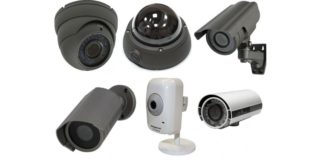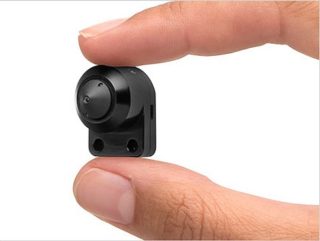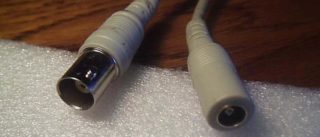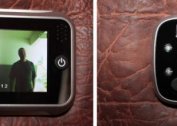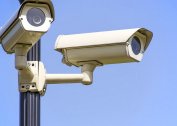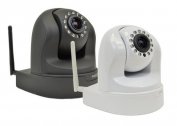Over the past few years, video surveillance has firmly entered the life of the population of many countries of the world. With the help of a small specialized video camera, you can easily find out what is happening directly at the front door, on the stairwell, in the courtyard of the house where the child is walking and / or the car is parked. By organizing a simple video surveillance system in your apartment, you can significantly increase your own security.
Types of CCTV cameras
In the modern market of electronic equipment there are video cameras that differ in different video surveillance technologies. They differ from each other in the way they transmit images and connect to a TV.
Analog camcorders
Analog CCTV cameras are considered somewhat outdated, but differ from other types in that they can be directly connected to the TV. Their disadvantage is that the image on the screen has a low resolution, which does not allow the owner to consider the fine details of the picture.
Further development of analog technology has led to the emergence of TVI / HDCVI / AHD cameras, allowing you to get a picture with a fairly high resolution on the screen. In this case, you cannot connect the camcorder to the TV directly - you must have a DVR.
There are surveillance cameras in high resolution, equipped with a switch that allows you to translate them into high-quality analog video mode. They can be connected directly to the TV.
IP camcorders
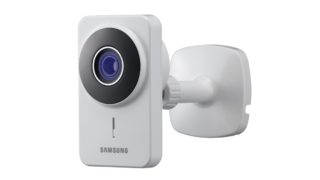
Wireless technology, which is used to transmit images by IP video cameras, has been developing in parallel with analog technologies. It allows you to get a high-resolution picture on the screen, which compares them favorably with any analog video camera. However, they are much more complicated and more expensive than analog ones, since they contain integrated digital filters, which can significantly improve image quality. In addition, a microphone and speaker can be mounted in the housing.
The IP video camera only connects to the TV through the DVR. Without the latter, it can be connected to a computer, tablet, smartphone with special software. Remember:
- IP-cameras have their own firmware;
- to connect you need a computer network;
- connection to a computer network is carried out using the RJ45 connector;
- IP cameras can be equipped with a WiFi interface.
All surveillance cameras have their own design features.
Design features of video cameras
Depending on the design of the camera, there are:
- internal and external;
- domed;
- miniature.
In addition, all camcorders are divided into black and white, color, mixed.
Internal and external
Internal and external surveillance cameras are designed for indoor or outdoor installation. At the same time, the internal ones are protected from external factors and are small in size and light in weight. The external ones are mounted in special cases, which allow working in any climatic conditions and protecting them from external factors (vandals, etc.). As a rule, external video cameras are installed far from the monitor, and therefore they must transmit a signal over long distances.
Case cameras in turn can be motionless and rotary.In the rooms, the fixed ones are mounted on brackets, and on the streets they are placed in a special thermal casing with heating and ventilation. If you need to monitor large areas, they are equipped with wide-angle lenses that have a zoom.
Camcorders equipped with a rotary mechanism can at certain intervals change the surveillance area according to a predefined program.
Dome Cameras
Dome cameras have an attractive appearance and can be installed both indoors and outdoors. They differ from other species by the presence of a high-speed rotary mechanism, which can move the zoom lens both vertically (180 °) and horizontally (360 °), allowing you to control areas with fast-moving objects.
Minicamera
The mini-cameras are used for covert surveillance, for which they are hidden, for example, in interior items so that it is impossible to notice the arrangement. The lens has a size no larger than the eye of the needle, and therefore the observation area is limited to small sizes.
The matrix of black and white cameras has a high photosensitivity and high resolution, which allows you to use them where you need a detailed picture. Color detail provides the transfer of color video, which makes the image on the screen more informative. Mixed cameras have the ability to change color depending on the time of day. At the same time, high-quality night shooting is carried out using IR illumination.
Features of connecting the camcorder to the TV
In order to quickly and easily connect a CCTV camera to a TV, you need to get supplies and components. Moreover, their composition is determined by the type of camcorder, its interfaces and the scope of delivery. The television must at least have an analog RCA video input. At the same time, most camcorders are equipped with RCA connectors.
Analog camcorders
Connecting a CCTV camera to a TV directly is carried out using RCA cables. Their colors will help to make a connection without errors - the yellow cable transmits the video signal, and the red and black (white) are designed to supply power - + 12V and "common", respectively. When the camcorder is removed from the TV, you can extend the RCA cable using an RG59 coaxial cable or twisted pair cable (Siamese cable).
To connect high-precision analog cameras (TVI / HDCVI / AHD), you will need an analog DVR.
To connect multiple cameras to one TV, you will need to purchase a 4-core processor or CCTV multiplexer. To connect one analog camera to several TVs, you will need to split the video signal using a CCTV splitter.
IP camcorders
To connect an IP camera, the user will definitely need an NVR network video recorder. In this case, to connect the cameras to the TV, you must perform the following steps:
- Cat 5/6 Ethernet cable to connect IP cameras to the NVR;
- connect the NVR to the TV with an HDMI cable;
- Connect the AC adapter to the NVR;
- turn on the NVR and the TV.
After performing these operations, a real-time image will appear on the TV screen.
The NVR network video recorder allows you to make a number of subtle settings: motion detection, face detection, alarm outputs, etc. A number of models are equipped with PoE outputs that allow you to connect surveillance cameras without an AC adapter.
